Related Research Articles
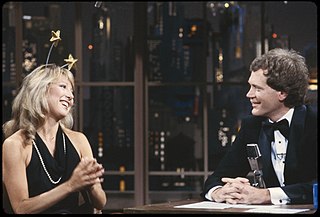
A talk show is a television programming, radio programming or Podcast genre structured around the act of spontaneous conversation. A talk show is distinguished from other television programs by certain common attributes. In a talk show, one person discusses various topics put forth by a talk show host. This discussion can be in the form of an interview or a simple conversation about important social, political or religious issues and events. The personality of the host shapes the tone and style of the show. A common feature or unwritten rule of talk shows is to be based on "fresh talk", which is talk that is spontaneous or has the appearance of spontaneity.
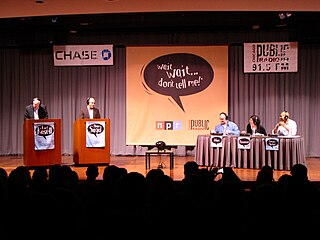
A panel show or panel game is a radio or television game show in which a panel of celebrities participate. Celebrity panelists may compete with each other, such as on The News Quiz; facilitate play by non-celebrity contestants, such as on Match Game and Blankety Blank; or do both, such as on Wait Wait Don't Tell Me. The genre can be traced to 1938, when Information Please debuted on U.S. radio. The earliest known television panel show is Play the Game, a charades show in 1946. The modern trend of comedy panel shows can find early roots with Stop Me If You've Heard This One in 1939 and Can You Top This? in 1940. While panel shows were more popular in the past in the U.S., they are still very common in the United Kingdom.

The $64,000 Question was an American game show broadcast in primetime on CBS-TV from 1955 to 1958, which became embroiled in the 1950s quiz show scandals. Contestants answered general knowledge questions, earning money which doubled as the questions became more difficult. The final question had a top prize of $64,000, hence the "$64,000 Question" in the show's title.

William Lawrence Cullen was an American radio and television personality whose career spanned five decades. Known for appearing on game shows and later as a prolific game show host, he hosted 23 shows, earning the nickname "Dean of Game Show Hosts". Aside from his hosting duties, he appeared as a panelist/celebrity guest on many other game shows, including regular appearances on I've Got a Secret and To Tell the Truth.
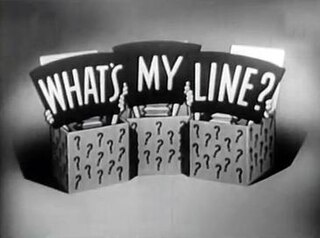
What's My Line? is a panel game show that originally ran in the United States, between 1950 and 1967, on CBS. The game show started in black and white and later in color, with subsequent U.S. revivals. The game uses celebrity panelists to question contestants in order to determine their occupation. The majority of the contestants were from the general public, but there was one weekly celebrity "mystery guest" for whom the panelists were blindfolded. It is on the list of longest-running U.S. primetime network television game-shows. Originally moderated by John Charles Daly and most frequently with regular panelists Dorothy Kilgallen, Arlene Francis, and Bennett Cerf, What's My Line? won three Emmy Awards for "Best Quiz or Audience Participation Show" in 1952, 1953, and 1958 and the Golden Globe Awards for Best TV Show in 1962.
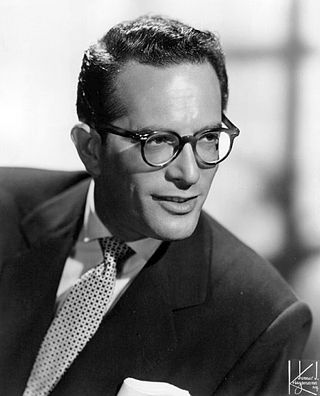
Robert Q. Lewis was an American radio and television entertainer, comedian, game show host and actor. Lewis added the middle initial "Q" to his name accidentally on the air in 1942. He was thinking of radio comedian F. Chase Taylor's character Colonel Lemuel Q. Stoopnagle, and "when I signed off, I declared 'This is Robert Q. Lewis.' I don't know why but that got lots of good reaction." He decided to retain the initial, telling interviewers it stood for "Quizzical."
Information Please is an American radio quiz show, created by Dan Golenpaul, which aired on NBC from May 17, 1938, to April 22, 1951. The title was the contemporary phrase used to request from telephone operators what was then called "information" and later called "directory assistance".

The Name's the Same is an American game show produced by Goodson-Todman for the ABC television network from December 5, 1951 to August 31, 1954, followed by a run from October 25, 1954 to October 7, 1955. The premise was for contestants to guess the names of persons whose actual name corresponded to a famous person, celebrity, a place, common object or action.

It Pays to Be Ignorant is a 1942–51 radio comedy show which maintained its popularity during a nine-year run on three networks for such sponsors as Philip Morris, Chrysler, and DeSoto. The series was a spoof on the academic discourse on such authoritative panel series as Quiz Kids and Information Please. At the same time, the beginning of the program parodied the popular quiz show Doctor I.Q. The show featured announcers Ken Roberts and Dick Stark. The program was broadcast on Mutual from June 25, 1942 to February 28, 1944, on CBS from February 25, 1944 to September 27, 1950 and finally on NBC from July 4, 1951 to September 26, 1951. The series typically aired as a summer replacement.

Harold Leonard Block was an American comedy writer, comedian, producer, songwriter and television personality. Although Block was a highly successful comedy writer for over 15 years, today he is most often remembered as an original panelist of the television game show What's My Line? who was fired from the show in its third season, reportedly for inappropriate on-air behavior. Block is a controversial figure in the history of television, denounced by some, while praised by others as a writer and for contributing to the original success of What's My Line?
Celebrity Time was an American game and audience participation television series that was broadcast on ABC in 1949 - 1950 and on CBS in 1950 - 1952. The original host was Douglas Edwards.
Down You Go is an American television game show originally broadcast on the DuMont Television Network. The Emmy Award-nominated series ran from 1951 to 1956 as a prime time series primarily hosted by Dr. Bergen Evans. The program aired in eleven different timeslots during its five-year run.
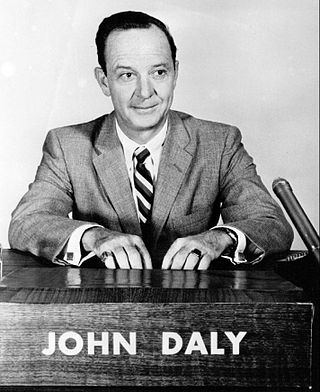
It's News to Me is an American panel game show produced by Mark Goodson and Bill Todman for CBS Television. It was a derivative of Goodson-Todman's own panel show What's My Line?. Originally aired as a one-time special on May 11, 1951; It debuted as a series July 2, 1951, to August 27, 1954.
Who Said That? is a 1948–55 NBC game show that ran on radio and television, in which a panel of celebrities attempted to determine the speaker of a quotation from recent news reports.

Twenty Questions, based on the guessing game Twenty questions, started as a radio quiz show in 1946. The television series ran on NBC in 1949, on ABC from 1950 to 1951 and on the DuMont Television Network from 1951 to 1954.
Who Pays? is an American television game show that was broadcast on NBC from July 2, 1959, to September 24, 1959.
Answer Yes or No is an American television game show that was broadcast on NBC from April 30, 1950, until July 23, 1950.
G. E. Guest House is an American television quiz program that was broadcast on CBS from July 1, 1951, until August 26, 1951. Oscar Levant was host for the first three episodes, after which Durward Kirby had that role. It was also known as Guest House and General Electric Guest House.
Anyone Can Win is an American television quiz program that was broadcast on CBS from July 14, 1953, until September 1, 1953.
References
- 1 2 3 "WHO'S WHOSE (review)". Weekly Variety. Variety Publishing Company. June 27, 1951. p. 31. Retrieved August 4, 2019.
- ↑ Brooks, Tim; Marsh, Earle (2007). "The Goldbergs". The Complete Directory to Prime Time Network and Cable TV Shows, 1946–Present (9 ed.). Random House Publishing. p. 545. ISBN 978-0-345-49773-4 . Retrieved July 10, 2018.
- ↑ "Sponsor Dropping 'Goldbergs' on TV". New York Times. May 19, 1951. p. 19. Retrieved July 10, 2018.
- 1 2 "Packagers Gripe In Web's 'Freeze' Of Kine Facilities". Weekly Variety. Variety Publishing Company. July 4, 1951. p. 35. Retrieved August 4, 2019.
- ↑ "A DOLLAR SAVED -- New TV Audition Gimmick Uses Tape, Still Photo". The Billboard. May 19, 1951. p. 11. Retrieved July 10, 2018.
- 1 2 "'Who's' Was". Weekly Variety. Variety Publishing Company. July 4, 1951. p. 32. Retrieved August 4, 2019.
- ↑ Clark, Rocky (July 1, 1951). "Tele-Views: 'WHO'S WHOSE' GONE". The Bridgeport Post (Connecticut). p. 19. Retrieved July 10, 2018.
- ↑ Wolters, Larry (June 28, 1951). "BIGGEST QUIZ ON WHO'S WHOSE: WHY BOTHER?". Chicago Tribune. p. W6. Retrieved July 10, 2018.
- ↑ "TV Critic Pleads for Mollie [sic] Goldberg's Return". The Wisconsin Jewish Chronicle. AJP. July 20, 1951. p. 3. Retrieved July 10, 2018.
- ↑ "(Dizzy Dean anecdote)". The Lincoln Sunday Journal and Star (Nebraska). July 8, 1951. p. 8-D. Retrieved July 10, 2018.
- ↑ Butterfield, C. E. (July 2, 1951). "Radio Column". Green Bay Press-Gazette. p. 17. Retrieved August 18, 2023.
- ↑ "Y. & R. May Quit Packaging AM-TV Shows; Shake-Up Due". The Billboard. August 4, 1951. p. 4. Retrieved July 10, 2018.